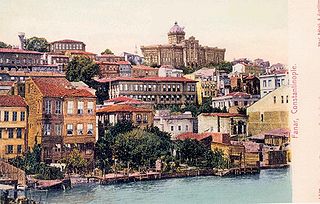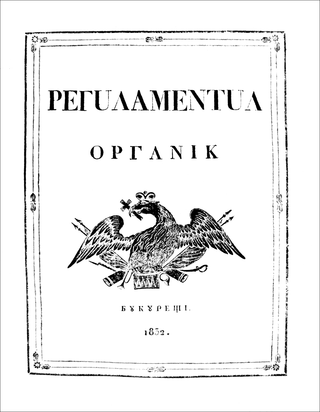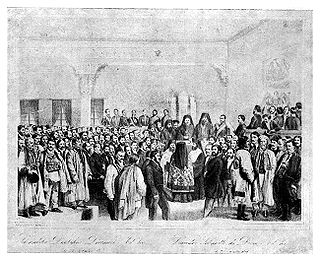
Moldavia is a historical region and former principality in Central and Eastern Europe, corresponding to the territory between the Eastern Carpathians and the Dniester River. An initially independent and later autonomous state, it existed from the 14th century to 1859, when it united with Wallachia as the basis of the modern Romanian state; at various times, Moldavia included the regions of Bessarabia, all of Bukovina and Hertsa. The region of Pokuttya was also part of it for a period of time.

Wallachia or Walachia is a historical and geographical region of Romania. It is situated north of the Lower Danube and south of the Southern Carpathians. Wallachia is traditionally divided into two sections, Muntenia and Oltenia. Dobruja could sometimes be considered a third section due to its proximity and brief rule over it. Wallachia as a whole is sometimes referred to as Muntenia through identification with the larger of the two traditional sections.
The Middle Ages in Romania began shortly after the withdrawal of the Roman legions from the former Roman province of Dacia in the late 3rd century and with the start of the Early Middle Ages and the Migration Period that followed afterwards respectively. It subsequently came to an end with the reign of Domn Michael the Brave (1593–1601) who managed, for a short time between 1599 and 1600, to rule Wallachia, Moldavia, and Transylvania together, the three principalities whose territories were to be united some three centuries later to form modern and contemporary Romania.
The Romanian Old Kingdom is a colloquial term referring to the territory covered by the first independent Romanian nation state, which was composed of the Romanian Principalities: Wallachia and Moldavia. The union of the two principalities was achieved when, under the auspices of the Treaty of Paris (1856), the ad hoc Divans of both countries, which were then under Ottoman Empire suzerainty, voted for Alexander Ioan Cuza as their prince. This process achieved a de facto unification under the name of the United Principalities of Moldavia and Wallachia. The region itself is defined by the result of that political act, followed by the Romanian War of Independence, the inclusion of Northern Dobruja and the transfer of the southern part of Bessarabia to the Russian Empire in 1878, the proclamation of the Kingdom of Romania in 1881, and the annexation of Southern Dobruja in 1913.

The Russo-Ottoman War of 1710–1711, also known as the Pruth River Campaign, was a brief military conflict between the Tsardom of Russia and the Ottoman Empire. The main battle took place during 18-22 July 1711 in the basin of the Pruth river near Stănilești after Tsar Peter I entered the Ottoman vassal Principality of Moldavia, following the Ottoman Empire’s declaration of war on Russia. The ill-prepared 38,000 Russians with 5,000 Moldavians, found themselves surrounded by the Ottoman Army under Grand Vizier Baltacı Mehmet Pasha. After three days of fighting and heavy casualties the Tsar and his army were allowed to withdraw after agreeing to abandon the fortress of Azov and its surrounding territory. The Ottoman victory led to the Treaty of the Pruth which was confirmed by the Treaty of Adrianople.

Phanariots, Phanariotes, or Fanariots were members of prominent Greek families in Phanar, the chief Greek quarter of Constantinople where the Ecumenical Patriarchate is located, who traditionally occupied four important positions in the Ottoman Empire: Voivode of Moldavia, Voivode of Wallachia, Grand Dragoman of the Porte and Grand Dragoman of the Fleet. Despite their cosmopolitanism and often-Western education, the Phanariots were aware of their Greek ancestry and culture; according to Nicholas Mavrocordatos' Philotheou Parerga, "We are a race completely Hellenic".

Budjak, also known as Budzhak, is a historical region that was part of Bessarabia from 1812 to 1940. Situated along the Black Sea, between the Danube and Dniester rivers, this multi-ethnic region covers an area of 13,188 km2 (5,092 sq mi) and is home to approximately 600,000 people. The majority of the region is now located in Ukraine's Odesa Oblast, while the remaining part is found in the southern districts of Moldova. The region is bordered to the north by the rest of Moldova, to the west and south by Romania, and to the east by the Black Sea and the rest of Ukraine.

The Treaty of Bucharest between the Ottoman Empire and the Russian Empire, was signed on 28 May 1812, in Manuc's Inn in Bucharest, and ratified on 5 July 1812, at the end of the Russo-Turkish War of 1806–1812. The Ottomans had done poorly in the war. The Sublime Porte above all wanted to stay out of the impending conflict between Napoleon's France and Russia. The Russians didn't want a war on two fronts, thus they made peace in order to be free for the upcoming war with France. The Ottomans had extricated themselves from a potentially disastrous war with a slight loss of territory. This treaty became the basis for future Russo-Ottoman relations.

The Treaty of Adrianople concluded the Russo-Turkish War of 1828–29, between Imperial Russia and the Ottoman Empire. The terms favored Russia, which gained access to the mouths of the Danube and new territory on the Black Sea. The treaty opened the Dardanelles to all commercial vessels, granted autonomy to Serbia, and promised autonomy for Greece. It also allowed Russia to occupy Moldavia and Walachia until the Ottoman Empire had paid a large indemnity; those indemnities were later reduced. The treaty was signed on 14 September 1829 in Adrianople by Count Alexey Fyodorovich Orlov of Russia and Abdülkadir Bey of the Ottoman Empire.

The Danubian Principalities was a conventional name given to the Principalities of Moldavia and Wallachia, which emerged in the early 14th century. The term was coined in the Habsburg monarchy after the Treaty of Küçük Kaynarca (1774) in order to designate an area on the lower Danube with a common geopolitical situation. The term was largely used then by foreign political circles and public opinion until the union of the two principalities in 1859. Alongside Transylvania, the United Principalities of Moldavia and Wallachia became the basis for the Kingdom of Romania, and by extension the modern nation-state of Romania.

The Battle of Vaslui was fought on 10 January 1475, between Stephen III of Moldavia and the Ottoman governor of Rumelia, Hadım Suleiman Pasha. The battle took place at Podul Înalt, near the town of Vaslui, in Moldavia. The Ottoman troops numbered up to 120,000, facing about 40,000 Moldavian troops, plus smaller numbers of allied and mercenary troops.
The Early Modern Times in Romania started after the death of Michael the Brave, who ruled in a personal union, Wallachia, Transylvania, and Moldavia – three principalities in the lands that now form Romania – for three months, in 1600. The three principalities were subjected to the Ottoman Empire, and paid a yearly tribute to the Ottoman Sultans, but they preserved their internal autonomy. In contrast, Dobruja and the Banat were fully incorporated into the Ottoman Empire.

The Principality of Transylvania was a semi-independent state ruled primarily by Hungarian princes. Its territory, in addition to the traditional Transylvanian lands, also included the other major component called Partium, which was in some periods comparable in size with Transylvania proper. The establishment of the principality was connected to the Treaty of Speyer. However, Stephen Báthory's status as king of Poland also helped to phase in the name Principality of Transylvania. Although the principality was essentially independent, it existed as an Ottoman vassal state for the majority of the 16th and 17th centuries, overseen by Ottoman Turkish sultans but ruled by Hungarian princes. At various points during this period, the Habsburgs also exerted a degree of suzerainty in the region.

Regulamentul Organic was a quasi-constitutional organic law enforced in 1831–1832 by the Imperial Russian authorities in Moldavia and Wallachia. The document partially confirmed the traditional government and set up a common Russian protectorate which lasted until 1854. The Regulamentul itself remained in force until 1858. Conservative in its scope, it also engendered a period of unprecedented reforms which provided a setting for the Westernization of the local society. The Regulamentul offered the two Principalities their first common system of government.

The Khotyn Fortress is a fortification complex located on the right bank of the Dniester River in Khotyn, Chernivtsi Oblast (province) of south - western Ukraine. It is situated on a territory of the historical northern Bessarabia region which was split in 1940 between Ukraine and Moldova. The fortress is also located in a close proximity to another famous defensive structure, the Old Kamianets Castle of Kamianets-Podilskyi. Construction on the current stone Khotyn/Hotin fortress was started in 1375, while major improvements were made in the 1380s and in the 1460s, under the Moldavian princes, Alexander the Good, and Stephen the Great.

The military history of Romania deals with conflicts spreading over a period of about 2500 years across the territory of modern Romania, the Balkan Peninsula and Eastern Europe and the role of the Romanian military in conflicts and peacekeeping worldwide.

The United Principalities of Moldavia and Wallachia, commonly called United Principalities or as Wallachia and Moldavia, was the personal union of the Principality of Moldavia and the Principality of Wallachia. The union was formed 5 February [O.S. 24 January] 1859 when Alexandru Ioan Cuza was elected as the Domnitor of both principalities. Their separate autonomous vassalage in the Ottoman Empire continued with the unification of both principalities. On 3 February [O.S. 22 January] 1862, Moldavia and Wallachia formally united to create the Romanian United Principalities, the core of the Romanian nation state.

The two Ad hoc Divans were legislative and consultative assemblies of the Danubian Principalities, vassals of the Ottoman Empire. They were established by the Great Powers under the Treaty of Paris. By then, the Crimean War had taken the two states out of Russia's sphere of influence, and had nullified the Moldo-Wallachian Regulamentul Organic regime. Officially, the two assemblies were provisional replacements for the traditional assemblies, the Sfaturi. The term "divan", is derived from the Ottoman rule, being the name of a high governmental body in a number of Islamic states.

The medieval fortress of Turnu is located in the southern part of Turnu Măgurele at a distance of 3 km from the city and 1 km from the confluence of the Olt and Danube rivers in today's Romania. The fortress is documented during the reign of Mircea the Elder (1394) and was built on the Danube line for the defense of Wallachia against the Turkish peril. At the end of the reign of Mircea the Elder, under unclear circumstances, it came under Ottoman occupation to return to the possession of Wallachia only in 1829 when it was burned and demolished.

The territorial evolution of Romania includes all the changes in the country's borders from its formation to the present day. The precedents of Romania as an independent state can be traced back to the 14th century, when the principalities of Moldavia and Wallachia were founded. Wallachia during its history lost several portions of its territory, either to the Ottomans or the Habsburgs. However, this land would be later essentially recovered in its entirety. Moldavia, on the other hand, suffered great territorial losses. In 1774, the Habsburgs invaded Bukovina and annexed it one year later, and in 1812, the Russian Empire took control of Bessarabia. Both territories were later exposed to powerful colonization policies. The principalities declared unification in 1859 as the Principality of Romania. This new state sought independence from the Ottoman Empire's vassalage, and in 1878, it fought a war against it alongside Russia. However, the latter would annex Southern Bessarabia, which was recovered decades before. Romania received Northern Dobruja as compensation, and would wage a war for the southern part against Bulgaria in 1913.

















